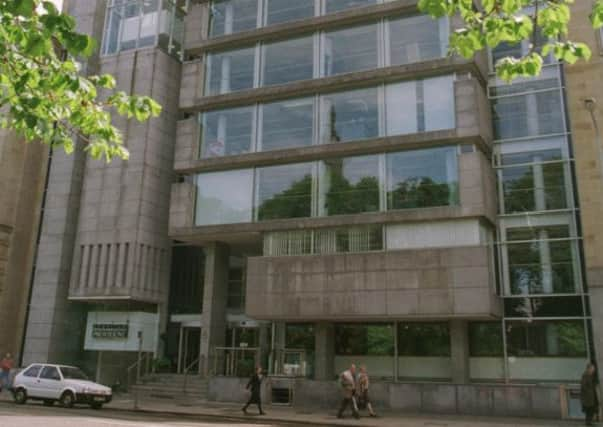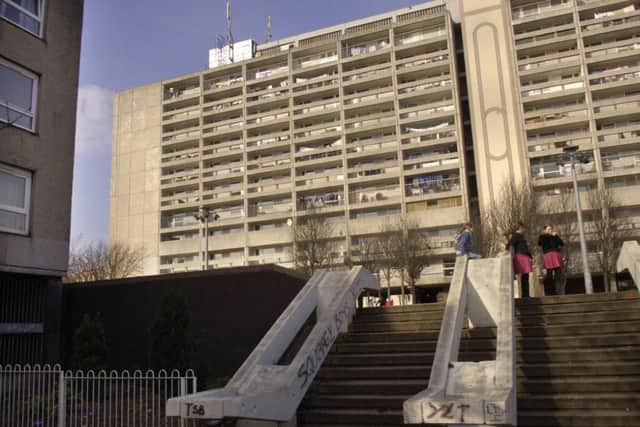Scotland’s endangered modernist architecture


At the foot of the pavilion’s imposing steps, a crowd is gathered around a table. Information is being picked up and read, conversation buzzes. Team Scotland is in full flow.
Though October is comparatively late in Biennale season, the Giardini is still busy with visitors from all over the world, creative, elegantly dressed types making the most of the bright autumn sunshine. Perth-based architect Fergus Purdie, leading this week’s Scottish team, reports meeting professors from Paris and the United States, and having a discussion about Patrick Geddes with a town planner from Tel Aviv.
Advertisement
Hide Ad“It’s been incredibly positive,” he says, with an enthusiasm even the Giardini’s legion of mosquitoes have been unable to dampen. “We’ve spoken to researchers, photographers, film-makers, it’s really broad. We’re almost running to keep up. People love the idea of a table outside, they have been sitting down and having conversations. What they’ve really engaged with is that we are the authors of the material, and they can speak to us directly.”


More remarkable still is what they’ve been talking about. Each of four Scottish groups have engaged with an aspect of modernism, publishing their research in a newspaper which they hand out free. Purdie’s group have produced a photo-led publication, Land Works, on the architecture of hydro-electric schemes built in the Highlands in the 1950s, buildings which few people even know about, and which have never been studied for their architectural value.
“It sounds strange to say it, but some of them are absolutely beautiful,” he says. “There are crafted aspects to them as well as monumentality. They have modernity written all over them because of their material, their form. They’re also generating electricity in a sustainable way. There are lessons to be learned here about design practice, sustainability, technology. I’ll end up becoming an anorak about hydro stations, because there’s a lot more to find out.”
Ian Gilzean, chief architect at the Scottish Government, visiting the project this week, says Scotland should be proud of the contribution it has made. “I think the impression was that looking at modernism would be quite staid, but there are so many stories, as Fergus and his team have discovered. I think it will be a very valuable piece of research in terms of assessing that period, and the relationship between architecture and society. Artists like Toby Paterson have been looking at this for a while, this is almost like the architecture profession catching up and saying we need to learn from this.”
The theme for the national pavilions – Absorbing Modernity: 1914-2014 – was set by this year’s Biennale curator, the Dutch architect and theorist Rem Koolhaas. Wandering from one pavilion to the next, the diversity of approaches becomes clear: Brazil has compiled a careful history of its own (important and sometimes overlooked) contribution to modernist architecture; Russia has repackaged its innovations from the last century in the language of the contemporary trade fair, perhaps ironically, perhaps not; the French have added a light touch courtesy of Jacques Tati; the Koreans use hard-to-obtain photographs of buildings in North Korea to contrast the modernist architecture of North and South. In the British Pavilion, maverick English architects FAT are exploring modernist housing schemes via Stonehenge, William Blake and A Clockwork Orange. And Koolhaas himself has curated Fundamentals, a fascinating, accessible show in the largest pavilion which strips architecture down to its component parts: windows, stairs, fireplaces, toilets.
Neil Gillespie, design director of Edinburgh-based architects Reiach and Hall, chosen to curate the Scotland + Venice project, Past + Future, says: “I liken it to going to the party with a carry-out. Take something with you, and create a conversation around it. England does sit between us and Europe, and this is an opportunity for somebody from Scotland to be on the ground and talk to people directly.”
Advertisement
Hide AdHe encouraged four teams – each in residence for a week at the British Pavilion – to look at buildings created in Scotland between 1950 and 1970, and to avoid the “big hits” of Scottish modernism, which are already well documented. “Everyone knows about the work of Gillespie, Kidd & Coia, but there were a whole lot of other people who were interesting as well. I spend my life in bookshops looking for architects I’ve never heard of. I think of it as tilling the compacted soil of history: you might unearth a treasure.
“It’s very controversial. For the majority of people, these buildings are grim, they are difficult buildings to love. People want to know why they haven’t been demolished. The people working on these buildings were serious about making a better environment for people to live in, but that work is vilified now. I’m trying to ask why that is, to open up a discussion about that.”
Advertisement
Hide AdMany of the buildings highlighted in the research are overlooked and under-appreciated: the recently demolished Scottish Provident building in St Andrew Square, thought by many to be a fine example of modernism; the “Banana Flats” in Leith; the Gala Fairydean football ground in Galashiels, a hymn to concrete brutalism by maverick architect Peter Womersley; Glasgow’s Dental Hospital, and College of Building and Printing. Few records or studies exist for them, and in most cases, the practices which designed them have closed. It’s an illustration of how easily buildings can be lost, leaving glaring gaps in architectural history, and affecting not only our understanding of the past but how we build for the future.
Artist Toby Paterson, who draws widely on modern architecture in his art, was a guest of the first Scotland + Venice team. At their invitation, he spent a day in Leith looking at housing developments created there in the 1960s by now defunct practice Alison and Hutchison, including the Banana Flats, and found they had stood the test of time rather well. “I saw various exchanges that were heartening, that hinted that maybe aspects of this architecture have been accepted. There’s something about that architecture which is knitted into the old street plan in quite an interesting way.”
Paterson said more evaluation of modern buildings was urgently needed to stop gems being lost. “What I and a lot of other people relentlessly call for is a proper analysis of what’s good and what’s bad. Some seriously good things are being lost, and some stuff that doesn’t matter is being lost. There is a lack of nuance within that. Can we recognise that in time and make sure that we don’t excise entirely stratas of our architectural history? This project is flagging all that up, starting to crystallise something that a lot of people have been talking about for a long time.”
On their last day in Venice, Fergus Purdie and his team hosted a discussion event at the Ludoteca Santa Maria Ausiliatrice. The Renaissance interior, with its religious paintings, felt like a gloriously incongruous backdrop to a discussion of modernist hydro plants in the Highlands. But the audience quickly became engaged in a spirited debate about whether Scotland has its own distinctive brand of modernism, some contending that it has, others contending (just as energetically) that the question is irrelevant.
Maintaining a tactful silence was the next Scotland + Venice team, who had just arrived to take over the table in front of the British Pavilion. Led by Samuel Penn, a lecturer at Scott Sutherland School of Architecture and Built Environment, Robert Gordon University, Aberdeen, the team has focused its studies on the international influences on three modern Scottish buildings: Andrew Melville Hall in St Andrews, designed by James Stirling; an unbuilt design for Kirkcaldy Crematorium by Alison & Peter Smithson; and Gray’s School of Art in Aberdeen, the only major building by Michael Shewan, an eager disciple of Ludwig Mies Van Der Rohe. That building is now itself at risk of demolition.
Penn says: “We decided to choose buildings that weren’t peripheral or necessarily Scottish. We were interested in the idea of internationalism. We wanted to buck the trend, because we are rather against the whole idea that there was a Scottish modernism. Whatever happened in Scotland was part of a movement which was pan-European; to call it Scottish or English or French is a bit regressive and probably not very useful. It isn’t a narrow debate, it wasn’t a narrow movement.”
Advertisement
Hide AdSo, the conversation goes on, echoing out into the Via Garibaldi, over the waters of a nearby canal. In this city where the architecture has changed little for 400 years, the debate about modernity rages merrily. If the Scots came to Venice to start a conversation, it looks likely that they’ve succeeded, and that it will continue long after they come home.
• The 14th International Architecture Exhibition at the Venice Biennale continues until 23 November. To see the newspapers created by the Scotland + Venice project visit https://issuu.com/scotland_venice2014